

Rethinking Education as the Practice of Freedom: Paulo Freire and the Promise of Critical Pedagogy. Paulo Freire is one of the most important critical educators of the 20th century.[1] Not only is he considered one of the founders of critical pedagogy, but he also played a crucial role in developing a highly successful literacy campaign in Brazil before the onslaught of the junta in 1964.

Once the military took over the government, Freire was imprisoned for a short time for his efforts. Bringing the Blog to the Classroom: Special Topics Blogging and Presentations. - e-Literate. And three people do it, three, can you imagine, three people walking in singin’ a bar of Alice’s Restaurant and walking out?
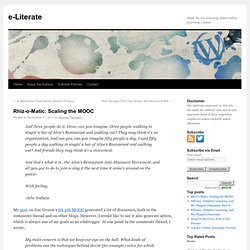
Don’t Lecture Me: Rethinking How College Students Learn. Flickr:AllHails At the star-studded Harvard Initiative on Learning and Teaching (HILT) event earlier this month, where professors gathered to discuss innovative strategies for learning and teaching, Harvard’s professor Eric Mazur gave a talk on the benefits of practicing peer instruction in class, rather than the traditional lecture.
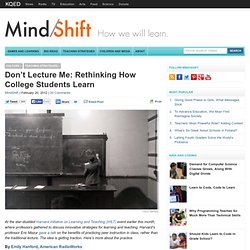
The idea is getting traction. Here’s more about the practice. By Emily Hanford, American RadioWorks. Authors: Jane Bozarth. Dr.

Jane Bozarth is the Elearning Coordinator for the North Carolina, USA, Office of State Personnel. She is the author of ELearning Solutions on a Shoestring; Better than Bullet Points: Creating Engaging Elearning with PowerPoint; From Analysis to Evaluation: Tips, Tools, and Techniques for Trainers; and Social Media for Trainers, coming out in August 2010. She is a popular conference speaker and is frequently found at both live and online international events.
She also serves as one of the moderators of the popular weekly Twitter event #lrnchat, Thursdays at 8:30 PM ET. Relaxing in the Digital Garden: How to Thrive in the 21st Century. "Garden.
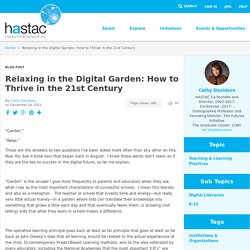
" "Relax. " Those are the answers to two questions I've been asked more often than any other on this Now You See it book tour that began back in August. I know those words don't seem as if they are the key to success in the digital future, so let me explain. “Garden” is the answer I give most frequently to parents and educators when they ask what I see as the most important characteristic of successful schools. Life in a 21st-Century English Class. Teaching Strategies Creating a Common Craft-style video is part of the classroom assignment.
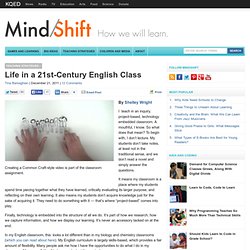
What skills should we be teaching to future-proof an education? Some time last year I spent quite a bit of time reflecting on what skills we could be focusing on in higher education to “future-proof” a degree.
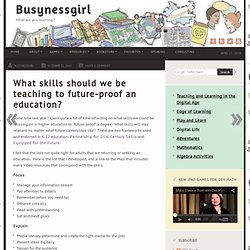
What skills will stay relevant no matter what future careers look like? There are two frameworks used and endorsed in K-12 education: Partnership for 21st Century Skills and Equipped for the Future. I felt that the lists not quite right for adults that are returning or seeking an education.
Challenge-Based Learning. Learner-Centered Classroom. Characteristics of Millennial Students: What Professors Need to Know. The first indication that the Millennial Generation may be different from previous generations is to consider how many different names we have for the generation and the people who belong to it.

They’re referred to as Generation Y, Nexters, Baby Boom Echo Generation, Echo Boomers, Digital Natives, Generation Next, Generation Me and, of course, Millennials. If nothing else, they’re one of the most studied generations. And while it’s important we don’t stereotype an entire generation of individuals, the large body of research on those born between 1981 and 1999 (or there about) has provided us with unique insights into their learning preferences, behaviors and attitudes. Christy Price, EdD, a psychology professor at Dalton State College, became interested in Millennial learners when she noticed a gap between students’ expectation for success and the effort they put forth in the classroom (Price, 2009).
Rhizomatic Learning – Why we teach? Teaching for Enduring Understanding. Earlier this summer I discussed the idea of backward design, which comes from Grant Wiggins and Jay McTighe’s excellent book Understanding by Design.
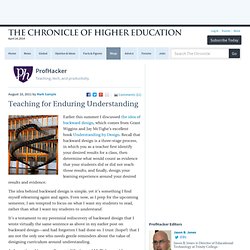
Recall that backward design is a three-stage process, in which you as a teacher first identify your desired results for a class, then determine what would count as evidence that your students did or did not reach those results, and finally, design your learning experience around your desired results and evidence. The idea behind backward design is simple, yet it’s something I find myself relearning again and again.
Planning a Class with Backward Design. It’s easy to switch into automatic pilot mode when it comes to planning a course.
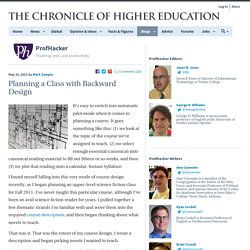
It goes something like this: (1) we look at the topic of the course we’re assigned to teach, (2) we select enough essential/canonical/anti-canonical reading material to fill out fifteen or so weeks, and then (3) we plot that reading onto a calendar. Instant Syllabus! I found myself falling into this very mode of course design recently, as I began planning an upper-level science fiction class for Fall 2011. I’ve never taught this particular course, although I’ve been an avid science fiction reader for years.